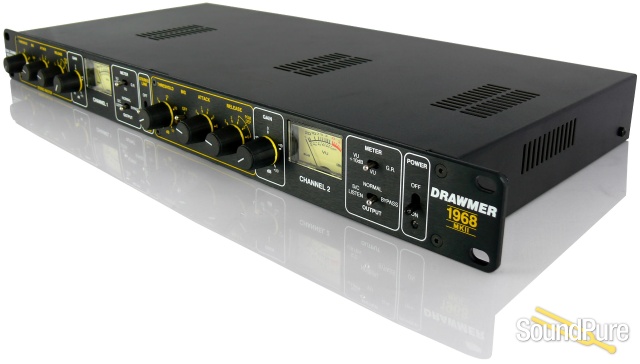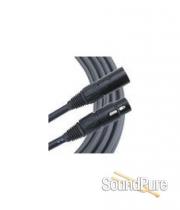-
Call Us Toll Free888-528-9703
-
Local/International (+1)919-682-5552
- Call Us! Toll Free! 888-528-9703
- Local / International (+1) 919-682-5552

Drawmer 1968 Mk2 Stereo Compressor From Drawmer
Blend valves and FETs for quality compression. The 1968 MkII is a 1U Tube/FET ‘stereo bus’ compressor which by design delivers a transparent ‘open’ sound even during periods of heavy compression.
$1,979.00
Retail: $2,199.00
"Experience the Difference"
 Payments as low as $45/mo.
Payments as low as $45/mo.
Manufacturer's Description from Drawmer
The original Drawmer 1960 used a tube stage at the front of the compressor, whilst the 1968 MkII utilises a J-FET (Field Effect Transistor) gain reduction circuit that operates faster than an opto-isolator. The compressor uses a 12AX7 tube makeup gain amplifier where you can add, with the Output Gain control, up to 20 dB of additional gain. The need for a ratio control has been removed as the compressor operates on the soft knee principle where the onset of compression is progressive.
The 1968 MkII expands attack times to six choices: 2, 9, 15, 25, 30 and 50 ms. Release times come in three fixed times (100ms, 500 ms and 1 second) and three program-dependent choices--200 ms to 2 sec, 500 ms to 5 sec and 1 to 10 seconds--all program-dependent and automatic.
The 1968 MkII provides full sidechain access for connecting an external equalizer for vocal stressing or de-essing.
Featured on both channels is a switchable ‘BIG’ and ‘BIGGER’ mode which applies less processing to the fundamental low frequency but still disciplines the upward associated harmonics which if untamed can result in a ‘boomy’ or ‘boxy’ sound. The result - a solid bottom end with enhanced sub-bass and a smoother, wider frequency response overall. This lets the operator use more compression on an overall mix with less pumping action caused by a kick and/or bass instrument.
The outputs of Channels 1 and 2 are monitored on two yellow illuminated VU meters - with a red warning glow to signify ‘approaching clipping’. A three-position switch adjusts the meters to show either normal output level, gain reduction or VU +10dB mode, which re-scales the meter for users working at ‘hot’ output levels.
An output switch selects normal compressor output, hard-wired bypass and sidechain listen.
Key Features
♦ 2 Channel Tube/FET Compressor.
♦ 2 soft-knee compressors with variable threshold, attack, release and output gain.
♦ Switchable BIG and BIGGER control on each channel.
♦ Dual mono or true stereo link operation.
♦ Side chain access and side chain listen facility.
♦ VU metering of gain reduction and output levels.
♦ Switchable +10dB mode on VU re-scales the meter for users working at ‘hot’ output levels.
♦ VU red warning glow to signify ‘approaching clipping’.
♦ Balanced +4dB XLR in/outs.
♦ Expanded the BIG to include BIGGER - setting the filters to 75Hz and 150Hz.
♦ Added internal jumpers that can be configured to remove the soft clip section.
♦ Added internal jumpers to make the output hotter by 6dB, if required.
♦ Improvement have been made to the PSU to lower the noise floor.

About Manufacturer
Specifications
| Frequency Range |
<17 Hz to 28 kHz (-1 dB)
<10 Hz to 47 kHz (-3 dB) |
| Input Impedance |
20 Kilohms
|
| Output Impedance |
50 Ohms
|
| Maximum Input Level |
+20 dBu
|
| Maximum Output Level |
+21 dBu
|
| Noise |
-85 dB (at Unity Gain, 22 Hz to 22 kHz, RMS)
|
| Crosstalk |
70 dB (at 10 kHz)
100 dB (at 1 kHz) |
| THD + N |
With Bypass Selected: <0.01%
With Normal Selected: <0.35% |
| Audio I/O |
2x XLR 3-Pin Line Input (1 Stereo Pair)
2x 1/4" TRS Input (Sidechain, 1 Stereo Pair) 2x XLR 3-Pin Line Output (1 Stereo Pair) |
| Power Source |
AC Input (Built-In)
|
| Power Consumption |
13 VA
|
| AC Input Power |
115 / 230 VAC, 50/60 Hz (User Selected)
|
| Mounting |
Front: 4x Standard Rackmount Hole
|
| Color |
Black
|
| Material of Construction |
Metal
|
| Certifications |
CE, WEEE
|
| Dimensions |
19 x 8.9 x 1.7" / 48.2 x 22.5 x 4.4 cm
|
| Weight |
8.8 lb / 4 kg
|














